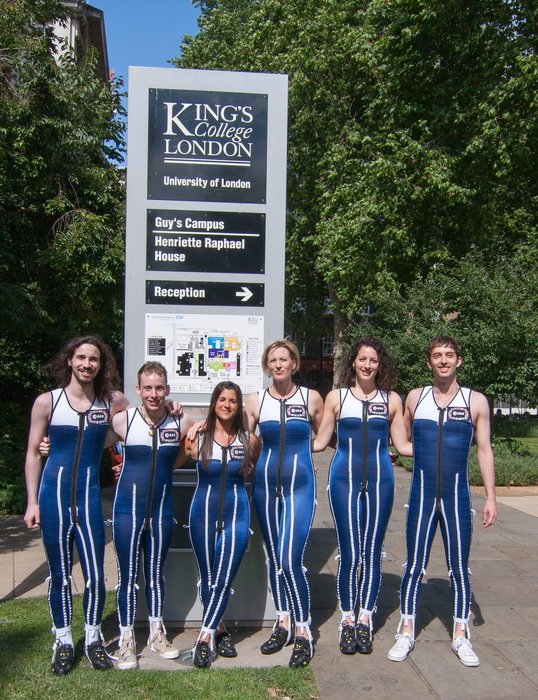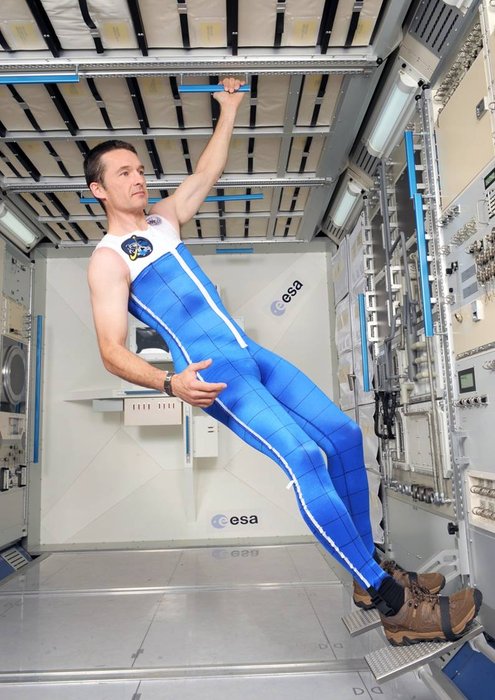Fellow ESA astronaut Alexander Gerst tweeted an image of Andreas Mogensen wearing SkinSuit to which Andreas jokingly replied “I cannot believe you revealed the identity of SkinSuit man!”. In this blog entry Alexander Frechette, Medical Projects engineer for SkinSuit who works for Wyle Labs in the European Astronaut Centre’s Space Medicine Office in Cologne, Germany, introduces the project and answered a few questions to reveal everything about SkinSuit.
Giving @Astro_Andreas last min infos during final @ESA_EAC training b4 #IRISS launch. Not about dress code though 😉 pic.twitter.com/Lbi3fwgNSb
— Alexander Gerst (@Astro_Alex) July 8, 2015
The SkinSuit is a skin-tight garment made to be worn inside the International Space Station and has been developed over a number of years to provide ‘loading’ in the head-to-foot direction, in effect recreating the load that gravity puts on all of us on Earth, but in weightlessness. The tight-fitting SkinSuit allows the simulated gravity-pull, called +Gz, to increase gradually from the shoulders to the feet to reproduce, as closely as possible, normal gravity. SkinSuit aims to counteract the stretching of the spine in space, which might be the cause of the lower back pain experienced by around half of astronauts in the early part of their missions. The ability to control spinal elongation in space might also help reduce the risk of post-flight injury to the spine’s intervertebral discs – commonly called a herniation or ‘slipped disk’ – which astronauts are at greater risk of experiencing when they return to Earth.
The objectives of the Operational and Technical Evaluation of SkinSuit during the iriss mission are:
- Evaluate the ability of SkinSuit to counteract spine elongation and reduce, or even prevent, lower-back pain. This will be assessed through frequent measurements of Andreas’s height as well as a questionnaire that he will fill out;
- Measure the +Gz load that SkinSuit provides whilst on the Space Station using NASA’s Force Shoes. The load will be measured in three standard postures to evaluate the typical loading that will be experienced by Andreas during a day on the Station;
- Evaluate operational considerations, in particular in regard to hygiene (by collecting microbiological skin swabs), and comfort, temperature regulation and range of motion (by completing questionnaires);
- Evaluate the effect of wearing SkinSuit while exercising on the Station’s bicycle exercise machine.
The SkinSuit itself will be launched with Andreas on Soyuz 44S.
How was the SkinSuit made?
Each SkinSuit has to be individually tailored and a professional tailor from Dainese took over 150 measurements of Andreas’s body. Andreas’s body mass and height were also measured to further customise his SkinSuit.
What type of material is the suit made of?
The upper part of SkinSuit is made of a non-stretch canvas with internal padding, and the loading part that compresses the spine is made from a material with a bi-directional elastic weave, producing large amounts of vertical load without being too tight around the legs and body.
Is it difficult to put on?
As SkinSuit is skin-tight, it is like putting on a wetsuit, but slightly more difficult. We tested donning the suit in weightlessness during parabolic flights without any major issues. The suit can be removed in less than 30 seconds in case of emergency.
What happens after the mission, will the suit return to Earth?
The SkinSuit will return to Earth on Soyuz 42S when the iriss mission is complete. It will then be tested again under the same conditions as before the mission, to see if, or how, it was affected by its use on the Station.
How will you get feedback from Andreas/measure results?
We will use a combination of daily height measurements, +Gz loading measurements (using NASA Force Shoes) and microbial skin swabs to collect objective data about SkinSuit. We will also ask Andreas to complete a series of questionnaires to give feedback about the suit and any symptoms of back pain he might experience.
What considerations went into the design?
The main consideration was to ensure that the suit provides enough loading to counteract spinal elongation, but of equal importance was the suit’s comfort – any garment that loads the body comes with a risk of discomfort to the wearer – as the suit is designed to be worn for long periods and should not inconvenience the astronaut. Less loading leads to less risk of discomfort, so our goal was to identify the minimum load necessary to counteract spinal elongation. How SkinSuit is used operationally and its physical appearance were also considered, as they are important for user acceptability.
What is the experiment setup?
Early studies indicated that sleeping in a SkinSuit might negatively impact the astronaut’s sleep due to the suit’s +Gz loading and the sensation of pressure on certain parts of the body. On Earth, gravity does not compress your spine when you lie down to sleep or produce pressure on the shoulders or the feet – imagine trying to sleep in a wetsuit while standing up. As astronaut well-being is central to the work of the Space Medicine Office, denying Andreas proper rest would not be acceptable so he will only wear SkinSuit during the day.
Andreas will wear SkinSuit for between four and eight hours on three consecutive days, starting on Flight Day Three. This period was chosen after a laboratory study performed at King’s College London showed that SkinSuit reduced spinal elongation after about four hours, while eight hours is a full working day on the Space Station. Starting from Flight Day Two, Andreas will measure his height twice each day until Flight Day Seven. We expect to see his height increase across the mission as a whole, but hope that the increase will slow down or even stop on Flight Days Three to Five.
Andreas will also monitor his back pain every day – not all astronauts experience back pain, but, if Andreas does, we hope to see some positive changes in his symptoms on the days he wears SkinSuit.
This setup, with one so-called ‘baseline’ day without the SkinSuit on Flight Day Two, followed by three days wearing SkinSuit and three more days without it, is the best way for the team to achieve our objectives whilst minimising crew time and resources, allowing Andreas to support and participate in the most activities possible during his 10-day mission.
How did this project come about?
The project is a collaborative effort between ESA`s Space Medicine Office, King’s College London’s Centre of Human & Aerospace Physiological Sciences, the Massachusetts Institute of Technology’s (MIT) Aeronautics and Astronautics and Engineering Systems Department and University College London’s School of Pharmacy.
MIT invented and led the early development of SkinSuit, and continue to provide technical support. King’s College London provides human physiology expertise and University College London is investigating the microbiological (hygeine) aspects of the garment.
The SkinSuit that Andreas will wear on the Space Station is manufactured by Dainese based in Italy, who specialise in high-performance clothing.
ESA`s Space Medicine Office, based at the European Astronaut Centre, manages the project and provides expertise regarding space operations.

Testing SkinSuit at Kings College. Credits: Kings College London, Centre for Human Aerospace Physiological Sciences





Discussion: 2 comments
Skin suit is (only) a modern version of penguin suit?
I can’t believe that
Jonathan Scott from ESA’s Medical Projects and Technology Team Lead replies: “SkinSuit is based on the principle of the Penguin Suit – to apply a vertical load to the body in the absence of gravity – but is designed to significantly improve the distribution of the load and thus the comfort of the garment. The goal of the SkinSuit programme is to produce an effective garment that can be worn for prolonged periods of time.”